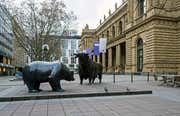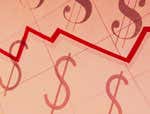Investors often have differing opinions about particular stocks or about the direction of the economy as a whole. Each trading day is analogous to a struggle between optimists and pessimists who buy and sell at various prices given different expectations. The stock market is said to incorporate all of the information that exists about the companies it represents, and that manifests itself as price. When optimists dominate, prices trend upwards, and we say that we are in a bull market. When the opposite is true, and prices trend lower, we are in a bear market.
[ Trading can be intimidating for those that are new to the market with terms like bull, bear, bubble, and volatility. If you're looking for a comprehensive introduction to trading, check out Investopedia's Trading for Beginners Course. You'll learn everything from terminology to how to build your own trading system in over five hours of on-demand video, exercises, and interactive content. ]
A bull market is when everything in the economy is running objectively well: people are finding jobs and unemployment is low, the economy is growing as measured by gross domestic product (GDP), and stocks are rising. Picking stocks during a bull market is arguably easier because everything is going up. If a person is optimistic and believes that stocks will go up, he or she is called a bull and is said to have a bullish outlook. Bull markets cannot last forever though, and sometimes they can lead to dangerous situations if stocks become overvalued. In fact, one severe form of a bull market is known as a bubble, where the upward trajectory of stock prices no longer conforms to fundamentals, and optimistic sentiment completely takes over. Historically, bubbles have occurred regularly dating back to the Dutch Tulipmania of the 1600’s – where the price of tulip bulbs rose so high that one could be worth more than a house – through to the housing bubble of 2008 that sparked the Great Recession. Bubbles always burst when reality catches up with overinflated prices, and people often realize bubbles in hindsight. It is difficult to recognize when investors are in a bubble and even harder to predict when it will pop.
A bear market is informally defined as a 20% drop in broad indices. Bear markets happen when the economy appears to be in or near recession, unemployment rises, corporate profits fall, and GDP contracts. Bear markets make it tough for investors to pick profitable stocks. One solution to this is to profit from when stocks are falling via short selling. Another strategy is to wait on the sidelines until you feel that the bear market is nearing its end, only starting to buy in anticipation of a bull market.
Bear markets are typically associated with an increase in stock market volatility, since investors typically fear losses more than they appreciate gains at an emotional level. People are not always rational actors – especially when it comes to money and investments. During bear markets, prices do not drop in an orderly or rational way to some fundamental level of price-to-earnings, but rather market participants often overreact in panic and send prices below reasonable valuations.
When there is panic, there is fear. Irrational behavior can spread, and markets can collapse. Expectations about future cash flows essentially drop to zero and people become more concerned with converting investments into cash than future growth. Only when rational investing behavior is restored does a bear market turn a corner. It is also worth pointing out that bear markets can be great opportunities for long-term investors to buy stocks “on sale” at relatively low prices, which can actually boost overall returns over long time horizons.
Stocks Basics: How to Read A Stock Table/Quote
-
 Insights
InsightsDigging Deeper Into Bull And Bear Markets
Discover why it's important to know the characteristics of bull and bear markets, the two types of market conditions. -
 Investing
InvestingAdapt To A Bear Market
Learn how your portfolio should evolve to suit bear market conditions. -
 Investing
InvestingEconomic Bubble: Toil And Trouble!
You might like the idea of profiting from a bubble, but you’d probably like to avoid suffering from its aftermath. Here is how an economic bubble works. -
 Financial Advisor
Financial AdvisorPreparing Your Clients for the Next Bear Market
It has been almost six years since the last bear market, so it might be time for advisors to start preparing their clients for the inevitable downturn. -
 Insights
InsightsFive Of The Largest Asset Bubbles In History
The five bubbles discussed here were among the biggest in history; their lessons should be heeded. -
 Investing
InvestingThe Wall Street Animal Farm: Getting To Know The Lingo
Finance professionals speak a different language, but the terms they use are more familiar than you think. -
 Insights
InsightsHow Bull Markets Past and Present Stack Up
Looking back at the history of bull markets can give some context on where we currently stand. -
 Insights
Insights5 Ways To Spot The Next Stock Bubble - And Avoid It
Playing a market bubble could pay off, but it carries a lot of risk. Avoiding it could be the way to stay profitable. -
 Investing
InvestingBear Market Mutual Funds Are Attracting Investors (BEARX, GRZZX)
Bear funds take short positions on the market and profit when prices go down. -
 Insights
InsightsHow Do Asset Bubbles Cause Recessions?
Understand how asset bubbles often lead to deep, protracted recessions. Read about historical examples of recessions preceded by asset bubbles.



